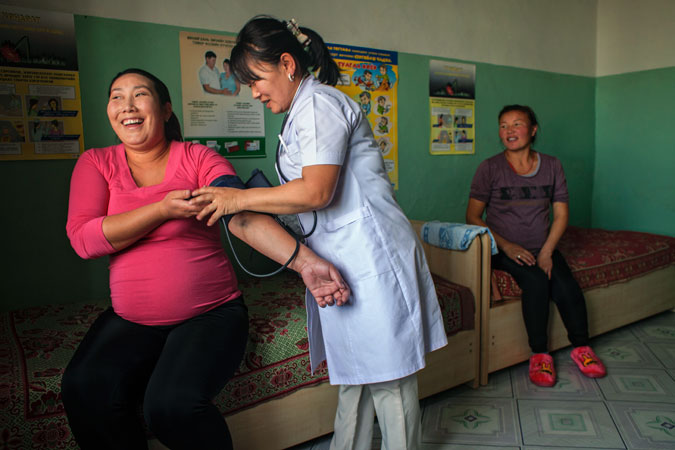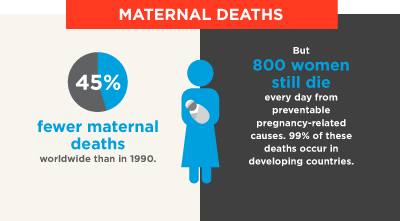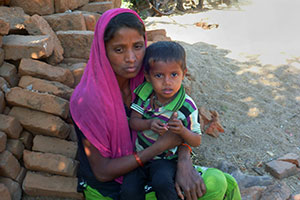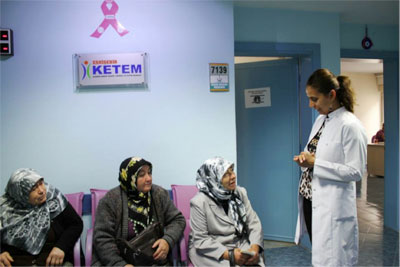SDG 3: Ensure healthy lives and promote well-being for all at all ages

Targets
- By 2030, reduce the global maternal mortality ratio to less than 70 per 100,000 live births.
- By 2030, ensure universal access to sexual and reproductive health-care services, including for family planning, information and education, and the integration of reproductive health into national strategies and programmes.
- By 2030, end preventable deaths of newborns and children under 5 years of age, with all countries aiming to reduce neonatal mortality to at least as low as 12 per 1,000 live births and under-5 mortality to at least as low as 25 per 1,000 live births.
- By 2030, end the epidemics of AIDS, tuberculosis, malaria and neglected tropical diseases and combat hepatitis, water-borne diseases and other communicable diseases.
- By 2030, reduce by one-third premature mortality from non-communicable diseases through prevention and treatment and promote mental health and well-being.
- Strengthen the prevention and treatment of substance abuse, including narcotic drug abuse and harmful use of alcohol.
- By 2020, halve the number of global deaths and injuries from road traffic accidents.
- Achieve universal health coverage, including financial risk protection, access to quality essential health-care services and access to safe, effective, quality and affordable essential medicines and vaccines for all.
- By 2030, substantially reduce the number of deaths and illnesses from hazardous chemicals and air, water and soil pollution and contamination.
- Strengthen the implementation of the World Health Organization Framework Convention on Tobacco Control in all countries, as appropriate.
- Support the research and development of vaccines and medicines for the communicable and noncommunicable diseases that primarily affect developing countries, provide access to affordable essential medicines and vaccines, in accordance with the Doha Declaration on the TRIPS Agreement and Public Health, which affirms the right of developing countries to use to the full the provisions in the Agreement on Trade Related Aspects of Intellectual Property Rights regarding flexibilities to protect public health, and, in particular, provide access to medicines for all.
- Substantially increase health financing and the recruitment, development, training and retention of the health workforce in developing countries, especially in least developed countries and small island developing States.
- Strengthen the capacity of all countries, in particular developing countries, for early warning, risk reduction and management of national and global health risks.
The highest attainable standard of health is a fundamental right of every person. Gender-based discrimination, however, undercuts this right. It can render women more susceptible to sickness and less likely to obtain care, for reasons ranging from affordability to social conventions keeping them at home.
Among women of reproductive age worldwide, AIDS is now the leading cause of death [1]. Not only are women biologically more susceptible to HIV transmission, but their unequal social and economic status undercuts abilities to protect themselves and make empowered choices.
Countries have committed to universal access to sexual and reproductive health care services, but many gaps have slowed progress so far. More than 225 million women have an unmet need for contraceptive methods [2]. In developing regions, where maternal mortality rates are 14 times higher than in developed ones, only half of pregnant women receive the minimum standard for antenatal care [3].
Fulfilling the right to health requires health systems to become fully responsive to women and girls, offering higher quality, more comprehensive and readily accessible services. Societies at large must end practices that critically endanger women’s health and well-being—among them, all forms of gender-based violence.
UN Women advances women’s well-being and health by working with governments to improve the provision of health services for women and girls, including survivors of violence, and backing non-governmental partners in filling gaps. The entity strives to end practices that endanger women and girls, such as child marriage, female genital cutting, dietary restrictions and others. The programmes help meet women’s health needs during medical humanitarian crises, restoring confidence in maternal and child health services in the wake of Ebola virus disease in West Africa. We also support and empower women living with HIV and AIDS.
Stories
Dying to live: the gender dimension of child mortality in India
Sharing the voices of Indian women, a new UN Women report details work towards meeting MDG targets and sheds light on the issue of female infanticide, son preference and violence against women.
Rural women access early cancer screening in Turkey
After receiving UN Women training on gender-responsive budgeting, a municipality in central Turkey analysed their public services and realized that women living outside the city could not access free cancer diagnosis and screening services. They now reach thousands of rural women with education and free transportation to screening centres.
Notes
[1] World Health Organization (2014), Fact Sheet No. 334.
[2] United Nations Population Fund (2014), Adding it up: The Costs and Benefits of Investing in Sexual and Reproductive Health, p. 10.
[3] United Nations (2015), The Millennium Development Goals Report 2015, p. 9.


